Blue and Yellow Macaw
Scientific Name: Ara ararauna
Habitat: LTropical and suptropical rainforests, lowland forests, savanas, and swampy woodlands
Diet: Herbivore
Weight: 2-2.6 lbs lbs
Conservation Status: Least Concern
Range: Northern South America .
Lifespan: 30-40 Years
Size: 30-40 inches
The Blue-and-yellow Macaw is a large, vividly colored parrot. Its striking plumage features bright blue feathers on the back, wings, and tail, contrasted by a rich golden-yellow chest and underparts. The face is mostly bare and white with fine black feather lines, and the bird has a large, powerful black beak adapted for cracking nuts and seeds. Their long tails and broad wings give them a graceful appearance in flight. Behaviorally, Blue-and-yellow Macaws are highly intelligent, social, and vocal, often found in pairs or small groups in the wild. They communicate through a range of loud calls and squawks, used to stay in contact across dense forests. These macaws form monogamous pairs that often last for life. Breeding occurs during the dry season; the pair selects a tree cavity for nesting. The female lays 2 to 3 eggs, which she incubates for about 24 to 28 days, while the male provides food. Chicks fledge at around 3 months of age and may remain dependent on their parents for several additional months.
Scarlet Macaw
Scientific Name: Ara macao
Habitat: Lowland rainforests, edges of the savanna, & gallery forests
Diet: Herbivore
Weight: 2.3-2.6 lbs
Conservation Status: Least Concern
Range: Central America into Southern Amercica .
Lifespan: 40-60 Years
Size: 33-35 inches
The Scarlet Macaw is one of the most vividly colored and recognizable parrot species in the world. It has predominantly bright red plumage across the head, shoulders, and chest, with yellow feathers on the mid-wing and blue on the lower wings and tail. Some individuals may also show hints of green on the wings. Its bare white facial skin is lined with small, dark feather lines, and it possesses a large, strong, pale upper beak and darker lower mandible. Scarlet Macaws are highly intelligent and social, often seen flying in pairs or small family groups, and sometimes larger flocks near communal roosting sites. They are known for their loud, raucous calls used to communicate across dense tropical forests. During breeding season, which varies by region but typically aligns with the dry season, monogamous pairs select tree cavities high in emergent trees. The female usually lays 1 to 4 eggs, incubating them for about 25 to 28 days, while the male helps by feeding her. Chicks fledge around 10 to 12 weeks after hatching and may remain dependent on their parents for several more months.
Military Macaw
Scientific Name: Ara militaris
Habitat: Tropical deciduous and semi-deciduous forests, wooded foothills, cliffside crevices, humid forests, and river canyons
Diet: Herbivore
Weight: 2-2.4 lbs
Conservation Status: Vulnerable
Range: Western coast of Mexico and South America. .
Lifespan: 50-60 Years
Size: 27-30 inches
The Military Macaw is a medium-large parrot recognized for its predominantly bright green plumage, which is accented by a red forehead, blue flight feathers, and a subtle yellow-olive tinge on the underparts. The bare facial skin is white and lined with small black feathers, and like other macaws, it has a large, curved black beak adapted for cracking hard seeds and nuts. Their coloration helps camouflage them in their natural forest and woodland habitats. Military Macaws are highly social birds, often found in pairs or small flocks, where they engage in mutual preening and vocalizations to maintain bonds. They are known for their loud, harsh calls, which serve as communication over long distances. In the wild, they inhabit tropical deciduous and semi-deciduous forests, usually at elevations ranging from 546 to 2,187 yards. Breeding typically occurs during the dry season. Pairs nest in tree cavities or cliffside crevices, where the female lays 1 to 3 eggs. She incubates them for approximately 26 to 28 days, while the male provides food. Chicks are altricial and fledge after about 12 weeks, remaining dependent for some time.


